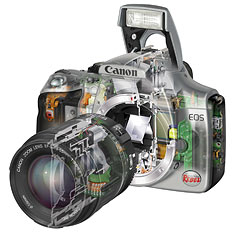In a technological, engineering, manufacturing
and branding stroke, Canon has taken the high ground in the exploding
digital camera market by introducing their bad-boy image EOS
Rebel single lens reflex camera in its first digital form, the
EOS Digital Rebel. Or is it the EOS 300D? Naa, it's the Kiss
Digital in Osaka.
Thank you, Mr. Canon, for giving America
some other presence in our minds than yet another VXG-5988-DXR-B
type designation. The digital camera field is rife with cameras
that are known by their apparent stock numbers, but the beginning
of the end of that practice may be at hand.
This one has an image --The Rebel--
which seems rather Johnny Yuma, Ram Tough, Route 66, F &
L in Las Vegas, Adding Life, Reaching Out and Touching Someone,
Having it My Way and encouraging me to wonder Where I Want to
Go Today. In other words, it's an image name that suggests a
lifestyle rather than a part number, and every time I pick it
up, I break with tradition and strike out to the beat of a different
drum. If the name alone can do all that, just think what the
price point and feature set might accomplish.
With an original base price of $999
including a unique 18 to 55 mm zoom lens that behaves like a
28.8 to 88 mm zoom on a 35mm SLR, the Digital Rebel cuts a new
swath across a market that is ready and eager to jump up to higher
quality digital photographic gear. Barely six months earlier,
Canon had introduced the 10D, a $1,499.95 digital body with the
same 6.3-megapixel image chip, and while it represents a solidly
professional digital camera to many professionals, it was over
the magic thousand dollar barrier by exactly half.
Update, November, 2004: You can buy
this bad boy for even less now. We've seen it for as little as
$630 on the Internet. Google it.
Being too smart by half is not always
a good thing. More than a few photographers have noticed over
the last few years that $300 SLRs exist for film photographers
--including lenses-- so why, oh why, can't someone make a dSLR
for a reasonable price? Canon's top of the line dSLR body (EOS
1D) with 11-megapixels topped the scales at nine grand. What's
with THAT?
As Canon bided its time and pushed harder
and harder into developing CMOS technologies while it moved to
garner market share in the digital camera fields of professional
and consumer gear, a contingent within the company was working
on the prosumer dSLR.
A 35mm EOS Rebel can find its way into
your hands for well under three or four hundred dollars, depending
on the model, and the Digital Rebel appears to borrow heavily
from the engineering that went into these entry level film SLRs.
But being digital and competing with
the compact digital cameras that have won the hearts and minds
of consumers over the last three years, the Reb had to deliver
something more than My First dSLR in order to compete.
Compact cameras are getting more and
more sophisticated and they do things the Rebel just doesn't.
Time-lapse, live viewing off angle and at arms length, best shot
selection, long strings of motor drive shots, panoramic image
assist, perspective correction, movies with sound, hip pouch
carry, white balance live manual setting and factory set fine
tuning, electric zoom, Internet picture co-generation and so
on.
Then again, the Digital Rebel does something
they can't do: See the image directly through the lens, gauge
flash with true TTL sensors, rapidly auto focus through a non-image
chip focus appraisal system, change lenses, crunch shutter lag
down to tolerable fractions of a second and deliver an image
that is much more pixel perfect and noise free.



 Today's
Digital Rebel may bring amused reminiscence a few years from
now when every feature in today's 11 megapixel super cam sells
for $500, but in today's digital camera market, a functioning
dSLR for >well< under a grand --with lens-- is a perceived
bargain. Especially something this talented.
Today's
Digital Rebel may bring amused reminiscence a few years from
now when every feature in today's 11 megapixel super cam sells
for $500, but in today's digital camera market, a functioning
dSLR for >well< under a grand --with lens-- is a perceived
bargain. Especially something this talented.
 Breaking the thousand
dollar barrier was a bold move, but it won't be the last sub-grand
dSLR. Nikon brought out their D70 in Spring, 2004, for around
the same price. Minus, that is, a lens.
Breaking the thousand
dollar barrier was a bold move, but it won't be the last sub-grand
dSLR. Nikon brought out their D70 in Spring, 2004, for around
the same price. Minus, that is, a lens. For
your Canon Digital Rebel- DSLR: Canon Digital Rebel EOS 300D
eBook is already on the shelf. DSLR: Canon Digital Rebel XT is
next. Then DSLR: Canon 20D follows. These are great cameras with
a great deal inside them, so we put a great deal of information
into their eBooks. You'll find things here that nobody else ever
told you about and not even Canon knew or could discuss.
For
your Canon Digital Rebel- DSLR: Canon Digital Rebel EOS 300D
eBook is already on the shelf. DSLR: Canon Digital Rebel XT is
next. Then DSLR: Canon 20D follows. These are great cameras with
a great deal inside them, so we put a great deal of information
into their eBooks. You'll find things here that nobody else ever
told you about and not even Canon knew or could discuss.